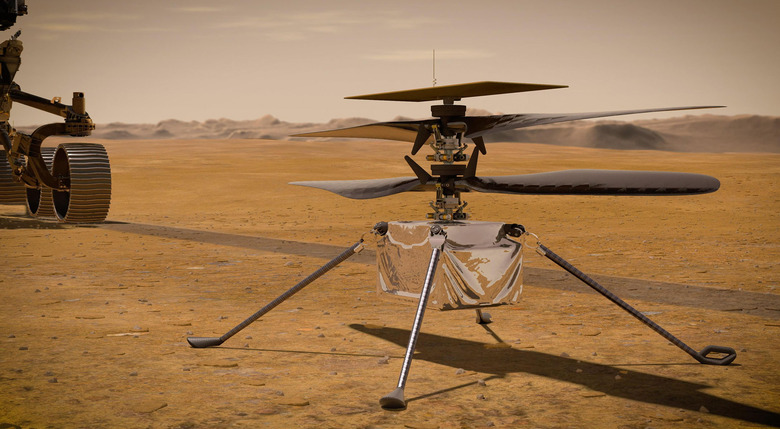NASA's Mars Helicopter Took Flight And Lived To Tell The Tale
History was made today, though you probably didn't realize it. After all, it was made on another planet. NASA's Ingenuity helicopter — a small machine designed to take flight in the Martian atmosphere — did exactly what it was supposed to do and took to the skies for roughly 30 seconds. It reached an altitude of just 10 feet, but that was enough to make it the first manmade aircraft to ever fly on another planet. It's obviously a very big deal for NASA, but it's also a huge step for humanity as a whole, and as we inch toward a future where humans visit other planets in person, it's a small but significant step.
The aircraft took off at 3:34 a.m. EDT this morning. NASA picked its flight window based on when it believed the helicopter would have the most available power and when flight conditions would be the most suitable. It's important that the helicopter not just fly but land safely, and if a gust of wind were to push the helicopter it might end up crashing and sustaining damage. Thankfully, that didn't happen.
As NASA explains in a blog post, the helicopter took off, climbed to an altitude of roughly 10 feet, sustained its hover for 30 seconds, and then slowly descended back to the surface where it landed softly. The entire event took 39.1 seconds. The helicopter did it mostly on its own, taking commands sent from Earth and then returning data after it had completed its flight. Due to the lag in communications between machines on Mars and their handlers back on Earth, real-time control isn't possible, so NASA had to sit and wait for the message from Ingenuity that it had succeeded in its quest.
Of course, hard evidence is also nice, so the helicopter snapped an image of the surface during its flight, showing that the helicopter achieved a stable hover. Check it out:

"Now, 117 years after the Wright brothers succeeded in making the first flight on our planet, NASA's Ingenuity helicopter has succeeded in performing this amazing feat on another world," NASA Associate Administrator for Science, Thomas Zurbuchen, said in a statement. "While these two iconic moments in aviation history may be separated by time and 173 million miles of space, they now will forever be linked. As an homage to the two innovative bicycle makers from Dayton, this first of many airfields on other worlds will now be known as Wright Brothers Field, in recognition of the ingenuity and innovation that continue to propel exploration."
Achieving flight was Ingenuity's ultimate goal, but it's not done yet. The aircraft has roughly a month to conduct multiple flights before it will poop out and no longer be usable. NASA's teams will surely be wanting to take the tiny copter for a few spins within that window, so we can expect additional information and images as those commence.
